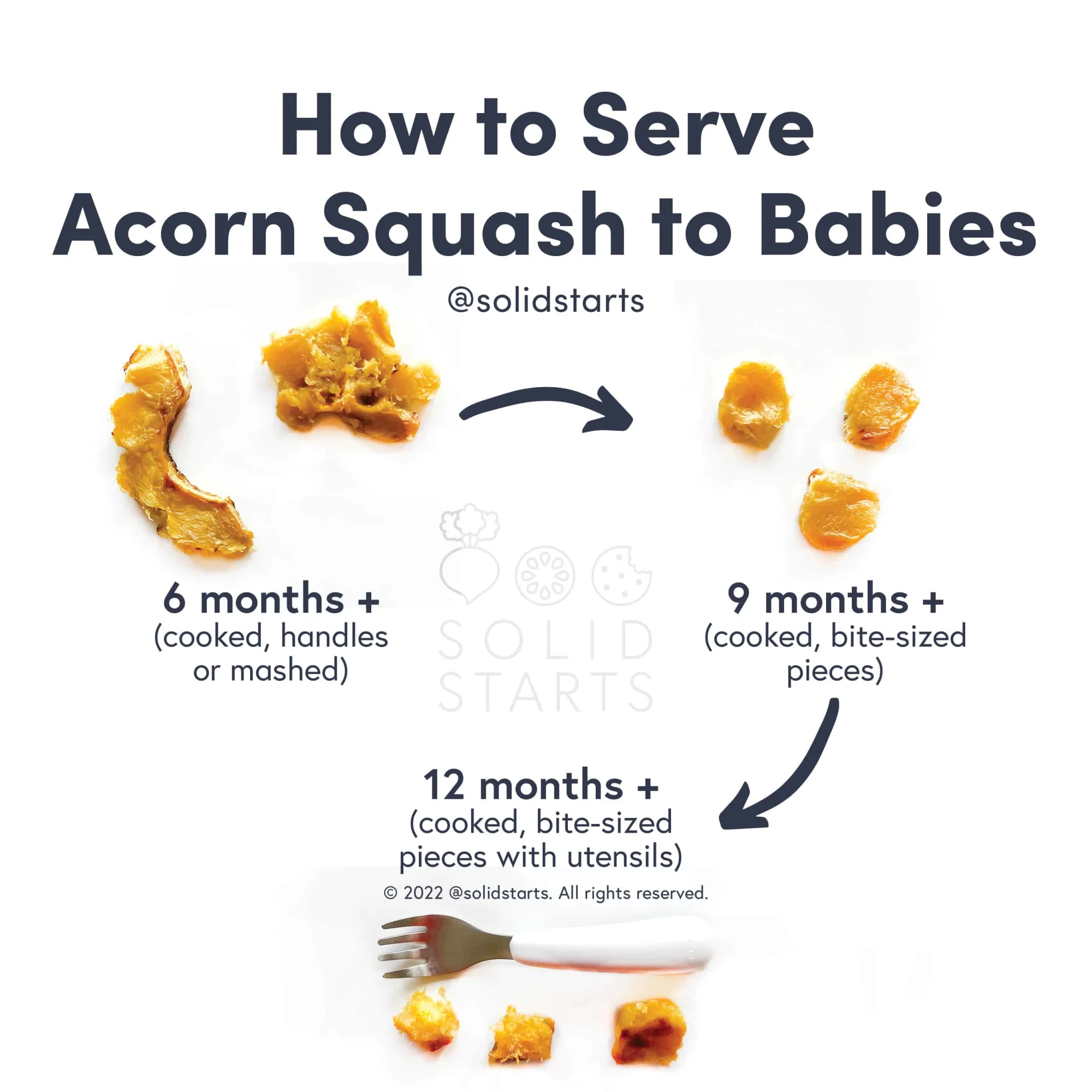Access our First Foods® Database in the Solid Starts App.
Learn moreAcorn Squash
Vegetable
Age Suggestion
6 months
Iron-Rich
No
Common Allergen
No

When can babies have acorn squash?
Acorn squash may be introduced as soon as baby is ready to start solids, which is generally around 6 months of age.
Humans have been eating squash for thousands of years, first in Central America—the plant’s native terrain—and later around the world as European colonizers took the seeds to different parts of the world. Crossbreeding and wild propagation have resulted in thousands of varieties of squash to try, including acorn squash and its winter squash siblings, delicata and spaghetti squash.
How do you serve acorn squash to babies?
Every baby develops on their own timeline, and the suggestions on how to cut or prepare particular foods are generalizations for a broad audience.
6 months old +:
Offer long crescents of fully cooked, soft acorn squash, seeds and skin removed, for baby to hold and munch on. The squash should be soft enough that it mashes readily when pressed gently. You can serve mashed cooked acorn squash, with other ingredients mixed in for flavor or added nutrition as desired (breast milk or formula, butter or yogurt, your favorite powdered spices, etc.) If you’d like to encourage use of a utensil, pre-load a spoon and rest it next to the food for baby to try to pick up or pass it in the air for baby to grab.
9 months old +:
Serve bite-sized pieces of fully cooked, soft acorn squash, seeds and skin removed, for baby to practice picking up with their developing pincer grasp, where the thumb and pointer finger meet to pick up smaller pieces of food. The squash should be soft enough that it mashes readily when pressed gently. You can also continue to serve cooked, soft acorn squash in longer crescents or wedges for baby to practice taking bites from. Mashed acorn squash is a great food for spoon practice at this age as well because it grips the spoon, increasing baby’s chances for scooping success and allowing baby plenty of time to get the loaded spoon to their mouth before all the food falls off the utensil.
12 months old +:
Continue serving bite-sized pieces or larger pieces of fully cooked, soft acorn squash, seeds and skin removed. Offer bite-sized pieces of the squash along with a fork to encourage utensil practice and help show how it is used by pre-loading the fork for the child to pick up independently or try spearing the squash while making a sound (boink!) to make it fun to use the utensil. If the child is not interested, keep in mind that using utensils can be exhausting for new eaters, and many children toggle back and forth between feeding themselves with their fingers and utensils. Try not to apply too much pressure—consistent and accurate utensil use will come in due time, often sometime after the second birthday.


How to cut acorn squash
How to prepare cooked acorn squash for babies
Learn all about the nutrients that babies need in our Nutrient Cheat Sheet.
Videos
Is acorn squash a choking hazard for babies?
No. Cooked, soft acorn squash presents a low risk when safely prepared for a child’s age and developmental ability, though, in theory, an individual could choke on any food. To reduce the risk, remove all seeds and prepare and serve acorn squash in an age-appropriate way as described in the How to Serve section. As always, make sure you create a safe eating environment and stay within an arm’s reach of baby during meals.
Learn the signs of choking and gagging and more about choking first aid in our free guides, Infant Rescue and Toddler Rescue.
Is acorn squash a common allergen?
No. Allergies to acorn squash are rare, though it’s not uncommon to get an itchy rash on the hands after handling winter squashes. To minimize any reaction, wash your hands after preparing the squash. Also, apply a barrier ointment (such as pure white petroleum jelly) to baby’s face before eating, and wash face and hands after eating.
As you would when introducing any new food, start by offering a small quantity on its own for the first few servings. If there is no adverse reaction, gradually increase the quantity over future meals.
Is acorn squash healthy for babies?
Yes. Acorn squash offers lots of fiber along with many B vitamins, including vitamin B6 and folate to help babies grow and thrive. Acorn squash also offers a little vitamin A, magnesium for overall cell function, and vitamin C, which helps baby’s body absorb iron from plant-based foods like beans, lentils, and nut and seed butters.
What are some great first foods for babies?
There are many wonderful options. Look for foods that are easy for baby to feed to themselves, that are low in choking risk, and that offer nutrients babies need, such as iron. A few of our favorite first foods include cooked broccoli, oatmeal, and mango pits.
Do I need to start solids with purees?
You can if you’d like, but there's no developmental need to start with textureless food. Babies can be served modified versions of what you eat. Use our First Foods Database to find how to safely serve any food.
Our Team
Written by
Expert Tips Delivered to Your Inbox
Sign up for weekly tips, recipes and more!
Copyright © 2025 • Solid Starts Inc







